by Yessica Morales

Providing access to health services for vulnerable populations is a priority in the universal health coverage plan (UHC), announced researchers Clara Juárez Ramírez, Alma Sauceda Valenzuela, Aremis Villalobos, and researcher Gustavo Nigenda.
In Mexico, they emphasized that indigenous women in Chiapas suffer 77% of maternal deaths in the country. There are various factors: cultural barriers, which make access to health care services difficult for indigenous populations.
For their research, selected two Mexican states as intervention centers for two different models of obstetric care. That is, rural and indigenous communities in Oaxaca for the standard (government) model of care and a Non-Governmental Organization (NGO) implemented a model of care in Chiapas1.
Thus, they explained that the standard model of care provides primary health care services through community health centers. The number and type of professionals depend on the population of each locality.
This model also includes health clinics, a medical center run by community health workers and mobile medical units. In the community, health workers, midwives and special brigades of the project identify pregnant women to attend prenatal consultations.

Meanwhile, the NGO model implemented by Compañeros in Health, is a public-private initiative offers services in public units, in which community volunteers are included who accompany the mothers in order to support them and a maternal health committee responds to obstetric emergencies.
At the same time, it offers ambulatory services, medications and staff trained to supervise the technical aspects of care. In both models, women must pay to travel about 30 to 70 kilometers, in order to access a secondary level of care (hospital). In cases of obstetric emergencies, hospitals provide ambulances, if available.
In the standard model, 15% of women do not start prenatal care during the first trimester of pregnancy and 28% register complications during pregnancy.
The women did not seek care in time due to economic, linguistic and cultural barriers, and were unable to make decisions on their own, the researchers added2
In the NGO model, 98% of the women began prenatal care during the first trimester and 29% had managed home births with midwives, health companions and midwives.
The main difference between the two models is that the NGO model adopts a rights-based approach, which emphasizes freedom of choice and allows women to choose their position during labor and the place for the birth.
Women value the freedom to choose, they felt they had adequate information and could make informed decisions about other sexual and reproductive health (SRH) services, such as family planning, Juárez Ramírez, Sauceda Valenzuela, Villalobos and Nigenda stressed.
In addition, they noted that health workers reported a lack of equipment in both the NGO and government models, and that women in general perceived the former model to be better.
Travel time to a secondary level of care was similar in both models. However, in the NGO model, there were compañeras who supported the process.

On the other hand, the percentage of reported abuse was higher in the standard model (28%) than in the NGO (15%). Both provide a place for women and families to wait during childbirth.
Similarly, in the NGO model, accommodations are offered to companions, while in the standard they only offer women from remote communities and it is not enough.
Given the above, the researchers highlighted the achievements of both models, the NGO model offers women the freedom to choose the type of provider, center and delivery they prefer, which translates into better sexual and reproductive health outcomes, including family planning decisions.
In this model, health companions support women through counseling and assistance with referrals, and women perceive it as a better experience.
The respectful model of childbirth allows women to make decisions throughout the process of pregnancy, childbirth and postpartum, and promotes alternative practices to the traditional model of care, based on scientific evidence, said Juárez Ramírez, Sauceda Valenzuela, Villalobos and Nigenda.
Originally Published in Spanish by Chiapas Paralelo, Monday, December 5, 2022, https://www.chiapasparalelo.com/trazos/tecnologia/2022/12/77-de-las-muertes-maternas-en-el-pais-se-producen-entre-mujeres-indigenas-de-chiapas/ and Re-Published with English interpretation by the Chiapas Support Committee
Footnotes
- The indigenous women in Chiapas who belong to the Zapatista National Liberation Army (EZLN, Ejército Zapatista de Liberación Nacional) receive health care services through the Zapatista Health Care System, which includes clinics, micro-clinics, ambulances, midwives, health promoters and a women’s hospital in La Garrucha.
- Chiapas remains one of the poorest states in Mexico. Three quarters of the population in Chiapas continue to live in poverty and a third of the total population of Chiapas live in extreme poverty.
